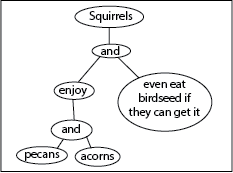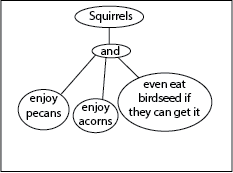List-Making Problems or What the Heck Is Parallel Structure?
The Internet is obsessed with lists these days. From the top 10 Hollywood dresses found the latest award event to 11 fun ways to pick your nose, lists are everywhere, but did you know that list-making—at least in the grammatical sense—can be fraught with problems? Or have you ever heard of the phrase parallel structure (or parallelism), maybe from an instructor as feedback on an essay? Before you submit that next writing assignment, check your work for lists that fall flat. 
Let’s start with an example sentence.
Squirrels enjoy pecans, acorns, and even eat birdseed if they can get it.
What’s wrong with this sentence? It made a list like everyone does in grade school with commas and conjunctions. To see the problem, you have to think about what a list is, what it is short for.
When you are making a list like this one, you are really shortening what could be multiple different sentences or sentence parts. Instead of writing out the same stem multiple times, you list and shorten. It works like this:
I love chocolate. I love ice cream. I love sandwiches.
Becomes
I love chocolate, ice cream, and sandwiches.
So far, so good. It also works in reverse. If you have a list, you should be able to break it down into multiple sentences with the same stem. That’s what’s called parallel structure. It means all the items in the list are the same form, so they all work with the stem to form grammatical sentences. Let’s try with the example.
Squirrels enjoy pecans. Squirrels enjoy acorns. Squirrels enjoy even eat birdseed if they can get it.
Oops.
That last part doesn’t work with the stem, but a simple fix can have this list functioning nicely.
Squirrels enjoy pecans and acorns and even eat birdseed if they can get it.

Now we’ve moved the stem back from Squirrels enjoy to just Squirrels. Here’s a visual example of our new sentence. Because few folks remember how to read sentence diagrams, it is just a simplified chart. In fact, it’s a pretty far cry from a real diagram. Notice how each list is joined with a conjunction, in this case and.
The first fix, “Squirrels enjoy pecans and acorns and even eat birdseed if they can get it” now has two lists. The first list has a root of Squirrels. The second has enjoy as its root; it is embedded within the first list.
We could also fix our sentence in a less elegant way:
Squirrels enjoy pecans, enjoy acorns, and even eat birdseed if they can get it.

This sentence has only one list with a root of Squirrels.
Finally, you could fix the sentence by breaking it into two:
Squirrels enjoy pecans and acorns. They will even eat birdseed if they can get it.
Since it’s such a simple problem to fix, you might wonder why so many people make this error. Well, a great number of writers have a phobia of too many ands. Someone at some point told them that they used and (or some other conjunction; or can show up in this list-making blunder as well) too many times. The natural response was to go through their writing, deleting as many ands as they could. They got a little carried away. If you’re in their boat, wondering which ands you need and which you don’t, just remember to check the stems. A sentence like this
Squirrels enjoy pecans and acorns and walnuts.
could easily be shortened to this
Squirrels enjoy pecans, acorns, and walnuts.
because all three items in the list have the same stem.
Squirrels enjoy pecans. Squirrels enjoy acorns. Squirrels enjoy walnuts.
This one simple check will get rid of many list-making problems and help you avoid using extra conjunctions. I’ll be back shortly to cover a few more list-making/parallel structure issues.
Photo Credit: John Schultz, Flickr, Creative Commons.
Non-diagram diagrams are my own.